A decade ago you would have been forgiven for thinking that the artistry of former times had long been extinct, that we would never see the same workmanship again, but amazingly artisans the world over are starting to awaken after a long hibernation. Jewellers, gem-setters, engravers and enamellers are joining forces with today’s leading horological masters to rekindle these ancient crafts and bring back all the glamour of watchmaking history.
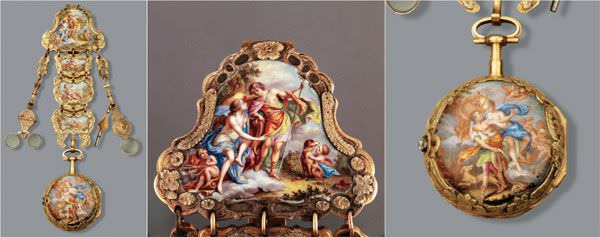
Watch with chatelaine by Philippe Dufalga Paris, circa 1780. Photo courtesy of La Musée de l’horlogerie, La Chaux-de-Fonds.

Ladies pendant watch, circa 1700, signed ‘C. Cabrier London’, painting on enamel by Huaud.
Ladies pendant watch, 19th century, gold, enamel, pearls, enamel medallion with field scenes.
Ladies bracelet watch, signed ‘Capt et Freundler Genève 1813’. Champlevé enamelled gold bracelet with links in the form of snakes with two small rubies for the eyes.
Photos courtesy of La Musée d’horlogerie du Locle
A quick look at women’s watchmaking history
Women’s watches first appeared at the end of the 15th century and were miniature versions of the spring-driven table clock. They were worn as adornments in the form of a sautoir necklace or on a chatelaine, a set of small ornamental chains that were suspended from a lady’s belt. Such objects were highly sought-after as they were a perfect accessory to communicate a lady’s status, wealth and intellect. One of the first female watch aficionados, and probably the most renowned, was Queen Elizabeth I (1533 – 1603) who had an extensive collection of timepieces. The Queen’s Equerry, the Earl of Leicester, was recorded as having presented her with a jewelled watch suspended from an ‘armlet’, the first known reference to the ancestor of the wristwatch. The Queen also owned a ring watch that not only told the time, but also served as an alarm with a small prong that came out and gently scratched her finger!
Nearly two centuries later, Marie Antoinette, the Queen of France (1755 - 1793), who was notorious for her love of all things extravagant, was busy acquiring her own collection of fine timepieces. She owned an array of watches and was even painted wearing two watches at the same time. In 1783 one of the Queen’s admirers ordered a spectacular watch for her from Breguet’s Quai de l’Horloge workshops in Paris. He commissioned a pocket watch with all the complications known to man. The piece was to be crafted in the finest metals at any cost. The timepiece took 44 years to produce and was sadly finished 34 years after the queen was beheaded. The story behind this incredible timepiece has become quite a thriller (see Malcolm Lakin’s article From Imperia to Versailles in this issue).
Come the 19th century, women’s watches had become more practical and comfortable to wear. They were often worn on simple chains around the neck or around the waist, in a broach or on a snuffbox. It was at this time that it became popular for women to wear their watches on the wrist with a delicate gold bracelet or ribbon. This new wrist format was ardently explored by the artists of the time, although men were still reluctant to adopt the wristwatch, saying that it was just a female fad that would die out! Men did finally adopt the wristwatch, as we now know, but it wasn’t until much later, at the end of World War I.
During the 1930s and 1940s, bracelets were very popular as a jewellery item and jewellers began to create watches in the form of bracelets with hidden dials. Women’s watches needed to be discreet as it was considered the height of impoliteness for a woman to look at the time on her wrist in public. After World War II, mass consumption and luxury returned as women desired more fashionable, feminine watches after being deprived of stylish clothes and jewellery for so many years.
However, it was the introduction of quartz in the 1970s that resulted in the biggest change to the
women’s watch industry as ladies’ watches could be made even smaller and cheaper than before. Women’s watches became mass-produced consumer goods and women’s mechan-ical watches almost died out forever. But, in the 1990s mechanical watchmaking made a remarkable comeback, albeit only in the men’s watch sector. Women were left with either the choice of a quartz watch or a man’s model. As more and more women started to choose a man’s mechanical watch over a quartz wristwatch, the watch brands realized that the women’s market was ripe for a change too and that’s where history ends and where we find ourselves today – in the midst of the most glamorous women’s watch revolution.
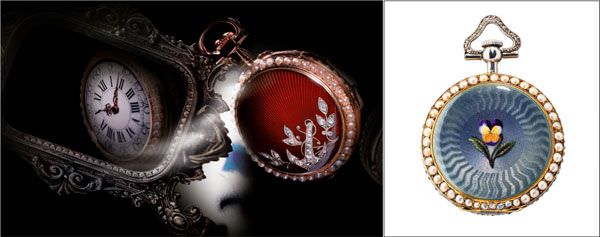
Ladies pendant watch by Jaeger-LeCoultre from 1890.
Pansy Watch by Joseph Chaumet. Circa 1900. Gold watch with pearls and a pansy flower on a guilloché mauve enamel background. Collection Chaumet Paris.
A change in the wind
The women’s mechanical watch segment has exploded these last few years as women search to make a statement with their watch as much as men do. Chronographs, perpetual calendars, world times, tourbillons and even minute repeaters are now also being designed for women. But on the whole, these complications are men’s watches that have been feminized – a mother-of-pearl dial, a diamond bezel, an el-egant strap and so forth. Retailers are reporting that such models are extremely popular with the ladies, but there are a small number of women who want more – they want a watch specifically designed for them, a watch that celebrates their femininity at the same time as showing their knowledge for fine watchmaking, a watch that reveals an appreciation for the arts, success, status and intelligence. Like the timepieces of the queens and nobility of times past, it is possible to have it all and a few brands are now creating some incredibly glamorous watches that combine the finest mechanical movements together with a multitude of different artistic forms, marking a new era of timepieces for women.
DeLaneau – a niche among niches
Shadowed by Geneva’s grand cathedral, a small brass plaque informs the passer-by of the workshops of DeLaneau. The building could be a lawyer’s office or the workplace of a notary, and yet, behind this unassuming old town house lays an inexhaustible talent for creating mechanical watches especially, and only, for women. In a world where timepieces are predominantly created by men for men, this relatively unknown company has found a tiny niche in the mighty world of horology, much to the joy of a very select number of knowledgeable and fortunate women.
The company’s CEO and Artistic Director, Cristina Wendt-Thévenaz, dedicates as much of her time to the aesthetics of the company’s timepieces as she does to the technical side. Each complication is created with women specifically in mind. There are no complications for the sake of complications, nothing masculine dressed up with diamonds, each movement is studied and created for women. When coming up with ideas for a new complication, “I start by thinking about what would trigger women’s emotions, trying to understand how they relate to time and their timekeeper, trying to cater to their pragmatic approach of how to use a timepiece, how to read time, how to interact with it,” explains Wendt-Thévenaz.
DeLaneau presented two beautiful women’s complications this year, the 1608 and the Angel Heart, which join a series of mechanical timepieces for women that range from moon complications to tourbillons. The 1608 is not a reference to a date, but rather the number of times this mechanical ‘digital’ watch jumps every single day. “It was a challenge to do a jumping hour with an additional jumping minute complication, but it was important because today we read digits as fast as, or faster than, we read the traditional hands on the watch,” she explains. But as the minutes jump, keeping today’s busy women on top of their schedules, the artistry and craftsmanship of the dial and case, in contrast, have a calming and peaceful influence over the wearer.
The 1608, with its discreet windows at 3 o’clock leaves the rest of the dial free for endless creativity. “I can play around with the design of the dial of the watch because I don't have the limitation of the hands,” explains Wendt-Thévenaz. (Photographed here is the Dôme Rectangle Soleil with its diamond rays of sunshine and ebony dial.) The decorative options are infinite with three different case shapes – round, square or rectangular – 12-hour or 24-hour clock, different precious metals, gem settings, enamel and more.
The second collection introduced this year was the romantic Angel Heart. The dial features a heart that opens into two angel wings revealing a small seconds display beneath. The wings open via a mechanical system linked to the crown and the movement is a limited edition automatic calibre. Dials come in enamel, set with precious stones, on ebony wood or with hand engraving, although the client can choose any kind of execution she falls in love with.
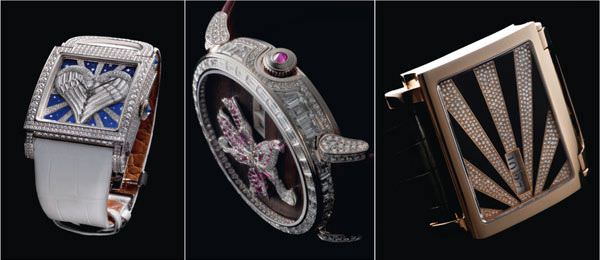
DôME CARRÉ ANGEL HEART LA NUIT, AMAZON FLEUR DE LYS and DôME RECTANGLE SOLEIL
Each DeLaneau piece is an individual work of art that is a combination of crafts meticulously executed by the company’s various partners - movement designers and manufacturers, stone setters, enamel artists, miniature painters, engravers and more. DeLaneau works with the very finest of Geneva’s master craftsman outside of the company, but is one of the rare watch companies that has its own high fire enamel workshop in-house that uses the age-old Geneva technique, a skill which almost died out and is still only known by a very small handful of people. “DeLaneau is really a patron of these artisans,” says Wendt-Thévenaz. "We are committed to keeping these traditional arts alive, and using them to benefit feminine horology…I believe that rare arts and crafts kept the real notion of luxury alive”
Van Cleef & Arpels’ – poetry of time
There are a number of companies that are probably more esteemed for their jewellery skills than their interest in haute horlogerie, but that are now investing as much energy in mechanical timepieces as they are in their jewellery creations. One such company is Van Cleef & Arpels, which over the last few years has created an array of feminine compli-cations combining the finest craftsmanship with first class watchmaking.
Van Cleef & Arpels is definitely not a newcomer to the women’s watch market. The company has been creating beautiful and original watches for women since 1910. In 1935, the padlock-inspired watch called the Cadenas was unveiled, with its unique clasp and snake-chain band that was to become one of many iconic collections for the brand. Its Tourniquet bracelet watch followed in 1937 with its yellow gold case and bracelet star set with rubies. Both are beautiful examples of Van Cleef & Arpels’ flair for combining the watch and the bracelet, which was to become so popular for the brand.

TOURNIQUET BRACELET WATCH, 1937, CADENAS WATCH, 1939 and MONTRE CLIPFLEUR by Van Cleef & Arpels
However, it wasn’t until the company’s centen-ary in 2006 that Van Cleef & Arpels decided to combine its expertise in design and jewellery with haute horlogerie. The first movement, called the Quantième de Saisons or perpetual seasons calendar in English, was a unique and exclusive complication showing the passage of the seasons and was designed specifically for women. Why a complication for women? “The first objective was to work on the Poetry of Time and mechanical complications were simply the best way to do this,” explains Louis de Meckenheim, Marketing Manager of Van Cleef & Arpels’ watch department. “Today, the indication of time is everywhere, from cell phones to the oven door, but paradoxically people do not take time to think of the value of their time. Our creations offer far more than the indi-cation of time or extraordinary craftsmanship, they tell a story.”
This first complicated timepiece, named quite simply the Lady Arpels Centenary, has a dial made up of two sections. The bottom section is fixed and made out of white mother-of-pearl, and the second section is an enamelled disc which rotates behind the mother-of-pearl section, depicting a fairy tale garden through spring, summer, autumn and winter. Each dial is hand painted by a master enameller and takes more than fifty hours of painstaking work to produce. The inventive movement turns the disc imperceptibly in pace with the change of the seasons.
The Centenary was not to be a one-off mechanical creation for women, as the following year saw the launch of the Lady Arpels Féerie, an equally enchanting mechanical timepiece for women. The dial depicts a fairy with wings set with round diamonds and a face represented by a pear shaped diamond. Her magic wand jumps from hour to hour and one of her gossamer wings indicates the minutes thanks to a retrograde movement – no easy feat considering the considerable weight of the diamond-set wand and wings. Behind the fairy is a dial of the richest blue enamel that has been hand engraved with a lozenge patterning or guilloché effect.
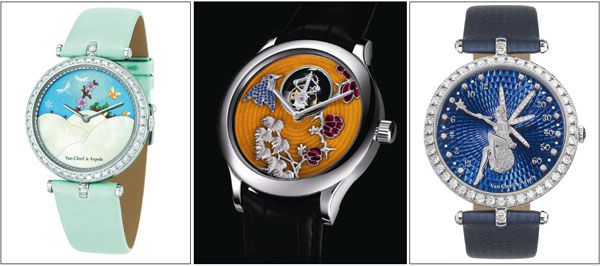
LADY ARPELS CENTENARY, TOURBILLON CADRAN UNIQUE COLIBRI with Chinese lacquer and precious stone setting by hand and LADY ARPELS FÉERIE equipped with a mechanical retrograde movement by Arpels & Van Cleef
Some watch companies start with a movement and then incorporate the design; at Van Cleef & Arpels, the opposite is true. “Once we have defined the design that suits the House DNA and universe, we then search for the best technique to give life to this design,” shares de Meckenheim. “Some of our lacquered pieces, for example, are made by master lacquers in the Wajima village in Japan. Since the 16th century the artists from this village are producing the most extraordinary Japanese lacquer – true pieces of art.”
Van Cleef & Arpels has a network of artisans with whom it has been working for many years. “We are always very faithful to our existing partners as long as they remain the best in their field… But we are always looking for new artisans, and I must say that over the years we have met some extraordinary people capable of realising our dreams. The recent boom has given light to new artists and this is certainly one of the main achievements of the success of this industry,” states de Meckenheim.
Since 2006, the company’s desire to unite the work of exceptional craftsmen and watchmakers has been going from strength to strength. The brand’s recent Tourbillon Collection is a perfect example, with each and every piece exhibiting the finest artistic crafts - mother-of-pearl inlay, high-fire enamelling, cloisonné enamelling, champlevé enamelling, lacquer work and the finest gem setting. All these works of art bring the beauty seen in historical timepieces back to the present day.
Jaeger-LeCoultre’s garden of creations
Jaeger-LeCoultre dazzled the watch industry and the film industry last year with the presentation of its Montres Extraordinaires - La Rose and La Tulipe at the Venice Film Festival (See Europa Star’s article Watchmaking and the cinema, united by art and glamour - 05/2007 issue). These two fabulous timepieces highlighted the amazing savoir-faire of the manufacture’s jewellers and setters. Jaeger-LeCoultre’s master watchmakers normally steal the limelight with their creations and inventions, but this time, it was the manufacture’s artisans’ turn to take centre stage, confirming the all-round talents of one of Switzerland’s oldest watch companies.

LA TULIPE AND LA ROSE by Jaeger-LeCoultre
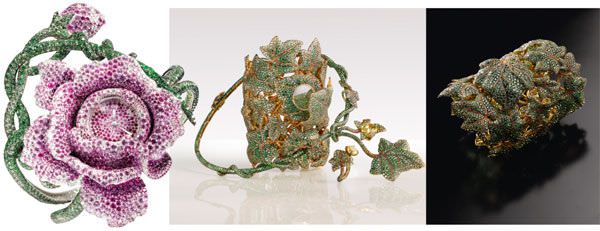
LA ROSE and PARURE EXTRAORDINAIRE LE LIERRE
This year Jaeger-LeCoultre’s artisans have outdone themselves with their Parure Extraordinaire Le Lierre. The set is made up of a cuff watch, a necklace, a ring and a pair of earrings that all follow an ivy theme. 12,000 precious stones totalling 160 carats were used to finish the creation including two exceptional yellow diamonds – one on the necklace (5.19 carats and internally flawless) and one on the ring (2.32 carats).
The cuff watch is an incredible work of art featuring a partially black, rhodium-plated, 18-carat yellow gold case cleverly concealed beneath one of the ivy leaves. Every detail faithfully replicates nature using an assortment of tsavorites (stones from the garnet family), yellow sapphires, emeralds and diamonds. The stones depict intertwining stems of ivy and the delicate nerves in the individual leaves that wrap themselves around the watch itself. The majority of haute joaillerie watches are equipped with a quartz movement due to the advantages of size, but not for Jaeger-LeCoultre, which has used its tiny 846 mechanical, manual winding, movement to discreetly register the time. For lovers of watch trivia, Jaeger-LeCoutre broke the record for the smallest mechanical movement, the famous Calibre 101, back in 1929 and still holds the record today.
Jewellery expertise is nothing new at Jaeger-LeCoultre. From 1925 onwards, the Manufacture’s tiny diamond-pavé rectangular watches were quite the ‘in thing’ during the Roaring Twenties. “Jaeger-LeCoultre has a real legitimacy in gem-setting,” shares Janek Deleskiewicz, Artistic Director. “We have our own integrated gem-setting workshop and have been specialized in this craftsmanship for many years.” These latest, one-of-a-kind creations take Jaeger-LeCoultre’s expertise to new heights. Not content with using traditional setting techniques, the Manufacture’s gem-setters invented two new setting techniques – the snow-setting and the rock-setting. The snow-setting is unique in that the tiniest diamonds nestle against each other to merge elegantly into the watch case, while the stones in the rock-setting are packed together so tightly that no trace of metal can be spotted between them. Only the lines that link the various elements of the case and the centre of the crown are visible.
There couldn’t have been a better place for unveiling the Parure Extraordinaire Le Lierre than the glamorous Venice Film Festival. Not only did this beautiful jewellery creation reflect the magic of the film world, but it was also displayed on the red carpet on the wrist of Jaeger-LeCoultre muse, the German actress Diane Kruger.
These incredible pieces are the brainchild of Richemont’s Artistic Director, Giampiero Bodino who wanted to follow the theme of nature. “Nature is a masterpiece of perfection that Jaeger-LeCoultre sublimates with its masterful technique,” he explains. Bodino chose ivy because he was seduced by the gracious lines of this eternal green plant, its strong symbolic power and its femininity.
What does the future hold for women’s watchmaking at Jaeger-LeCoultre? “Beauty will always come first, with authentic, legendary timepieces such as our Reverso, but also powerful women’s complications and creative, thematic dials and pieces of jewellery that show the time,” adds Deleskiewicz. “Just wait and see!” he concludes enticingly. Roll on the SIHH!
The return of decorative arts
The return of the decorative arts and horology shows that women’s watchmaking is certainly awakening. Beautiful timepieces with complications for women will most certainly remain a niche among niches, mainly due to their high price and limited availability, but that’s OK, as glamour wouldn’t be glamour if it was available to the masses, now would it?
The jewellery watch boom brings newcomers to Geneva
The lack of qualified watchmakers is a real problem in the Swiss watch industry, not only to ensure the supply to demand, but also to guarantee quality after-sales service in the future. But, it isn’t just the watchmakers that are in short supply - the recent trend for jewellery watches has also sent watch manufacturer’s scrambling in search of skilled jewellers and gem-setters to set their watches, both in-house and even abroad.
One such supplier to the Swiss watch industry is DJ Sertie, a French gem-setting workshop based in Lyon, France. The company’s order book has expanded exponentially with orders from watch companies over the last few years, so much so that the company has just opened a second workshop in Geneva to cater specifically to the watch industry. The company was created in 1993 by Jean Danielian and has 25 qualified gem-setters in Lyon and benches for a further 16 in Geneva.

DJ Sertie has an impressive operation that includes some of the latest technological equipment that the company uses hand-in-hand with the finest traditional craftsmanship. Each of DJ Sertie’s gem-setters is trained in-house over a period of five years, an enormous investment for the company, but one that has certainly paid off. The company is also very focused on its customer relationship management with a system that allows clients to follow the progress of their orders via Internet – something that will surely interest Switzerland’s watch manufacturers. A company to watch – no pun intended!
Source: Europa Star October-November 2008 Magazine Issue





